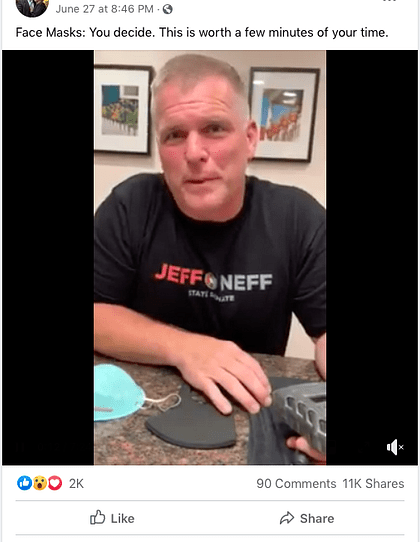Do Masks Make It Impossible to Breathe in Enough Oxygen?

In a viral video on Facebook, Jeff Neff, a candidate for Pennsylvania State Senate, measured the oxygen levels behind various masks and concluded that “No matter what you choose—head sock, neoprene-type fancy mask, cheap mask, N-95, the best available—none of them allow you to breathe in the required oxygen level.”

In the video, Neff used an MSA ALTAIR 5X Multigas Detector, a device produced by MSA Safety Inc., to measure oxygen levels behind different types of masks as he wears them. A typical atmospheric oxygen concentration level is about 21 percent, while the Occupational Safety and Health Administration defines an oxygen deficient environment as one in which that level is below 19.5 percent. Neff measured the oxygen concentration behind each mask as being below that level. However, MSA Safety says Neff misused the ALTAIR 5X and that the readings he produced are inaccurate. The product is intended to “detect potentially hazardous or combustible atmospheres in factories, rooms, work areas, and confined spaces much larger than the area inside a face covering,” Samantha D’Uva, a representative for MSA informed The Dispatch Fact Check. D’Uva said, quite plainly, that “Although the ALTAIR 5X detects the ambient levels of oxygen, carbon monoxide and other gases, it is not designed for the use shown [in the video].” She explained:
“When used to sample the air behind a face mask, the wearer’s exhaled breath would displace oxygen and subsequently put the ALTAIR 5X into oxygen alarm. The same thing would happen if you simply exhaled into the sample line. Due to the response and recovery time of the oxygen sensor, combined with the small space inside of the mask, the readings would not have time to reset before the next exhalation, resulting in a continuous alarm.”
If a proper measurement of oxygen had been taken, it would find what virtually every expert has affirmed since rumors like this began: Face masks do not obstruct oxygen flow or cause dangerous levels of carbon dioxide inhalation. When asked if masks pose a risk to wearers, Dr. Thomas Bice, an assistant professor of medicine specializing in prolonged mechanical ventilation and pulmonary diseases at the University of North Carolina Chapel Hill’s medical school, responded: “Will you be able to capture my eye roll?”
“The size of an oxygen molecule is so small that there’s no way that a mask could restrict the movement of oxygen across the mask,” Bice told The Dispatch Fact Check. “There may be a slight increase in carbon dioxide levels inside the mask relative to outside, but that would be so minute so as to not cause any issues.”
Bice pointed out that the ALTAIR 5X is being breathed on directly, so its measurements are affected by the higher carbon dioxide content of exhaled air. Notably, the oxygen value drops and then stays consistent in each of Neff’s experiments with masks. “Now if he was actually going to have difficulty breathing and getting sufficient oxygen, that value would go down, it would continue to go down,” said Bice. “I think the fact that it’s staying consistent … shows that despite repeated breathing in and out there’s no using up of the oxygen inside that mask.”
The purpose of any type of mask, from the N95 to the somewhat less effective cloth masks that are widely used, is to prevent droplets from passing through the mask. “Droplets that we’re concerned about are the size of, say, 5 to 10 microns, or micrometers … one-millionth of a meter, so very small,” said Bice. “Oxygen and carbon dioxide are measured in their size on the range of picometers … a million of them would fit inside one micrometer. So that’s how much smaller oxygen and carbon dioxide are than the droplets that we’re concerned about keeping out.”
If one wanted to accurately measure if someone wearing a mask was getting safe levels of oxygen, according to Bice the best tool to use would be a pulse oximeter, which detects hemoglobin that has bonded with oxygen in the blood. This would provide a more useful metric than just measuring oxygen levels behind a mask, Bice said, because “it’s not just a matter of what’s in front of your mouth, it’s a matter of whether your lungs can oxygenate to the body. And the good news is that your lungs can do a phenomenal job and use significantly less oxygen than even 19 percent and still maintain oxygen saturation. Even if 19 percent was what was right in front of [Neff’s] mouth while he was wearing the mask for 10 minutes there is no reason to think that his body would not get sufficient oxygen.”
The MSA ALTAIR 5X Multigas Detector was misused in the viral video and could not produce an accurate reading of oxygen levels under the circumstances. More accurate research, however, has shown that wearing a mask poses no threat to your oxygen levels and it is an important tool in preventing the spread of coronavirus.